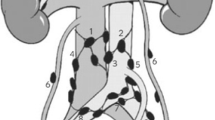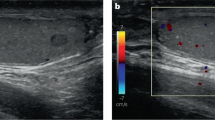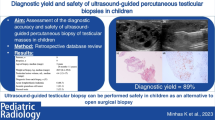Abstract
Purpose
The aim of the present study was to evaluate evolution of conservative echo-guided surgery for testicular tumours ≤1.5 cm and to assess the safety of this surgical procedure.
Methods
49 consecutive patients diagnosed with ultrasonography testicular lesions (mono or bilateral) ≤1.5 cm and treated with conservative echo-guided testicular surgery were examined. The parameters considered in this retrospective analysis included case history, physical examination, scrotal and abdominal ultrasonography, computed tomography scan, size of the nodule (maximum diameter), tumour markers, chest radiography, frozen section examination, histologic size of the tumour, overall survival (OS) and findings on follow-up.
Results
Mean age of patients was 33 years (range 18–62). Patients who presented with a palpable testicular nodule were 32.7 %, gynecomastia 10.2 %, precocious pseudopuberty 4 %, and scrotal pain 12.2 %. Permanent section examination confirmed the FSE data in all cases of certainty malignant lesion and definitive histological types were: 22 seminoma, 13 non-seminomatous or mixed germ cell tumours, 4 Leydig tumours, 2 hamartoma, 1 epidermoid cyst, 2 sertoli cell tumours, and 5 fibrous pseudotumour. No complications intra- and postoperative were observed. Overall survival was 100 % and scrotal US showed evidence of local tumour recurrence in 6 patients (12.2 %) after a mean follow-up of 34.7 months.
Conclusion
The OS, the low rate of local recurrence, and absence of complications, tend to demonstrate the safety of the procedure. The benefits to testicular-sparing surgery include improving the patient’s overall quality of life, fertility, endocrine function and negative cosmetic effects of radical orchiectomy.
Riassunto
Scopo del lavoro
Lo scopo del presente studio è stato quello di valutare il ruolo della terapia chirurgia ecoguidata conservativa nel trattamento dei tumori testicolari ≤1.5 cm e valutarne la sicurezza ed efficacia.
Metodi
Furono esaminati 49 pazienti con diagnosi ecografica di lesione testicolare (mono o bilaterale) ≤1.5 cm e sottoposti a chirurgia testicolare conservativa ecoguidata. I parametri presi in considerazione in questo studio retrospettivo furono la storia clinica del paziente, l’esame obiettivo, l’ecografia scrotale ed addominale, la TAC, le dimensioni della lesione, i marcatori tumorali, la radiografia del torace, l’esame istologico estemporaneo e definitivo della lesione, il tasso di sopravvivenza globale e i risultati del follow-up.
Risultati
L’età media dei pazienti è stata di 33 anni (range 18–62). Il 32.7 % dei pazienti presentavano un nodulo testicolare apprezzabile palpatoriamente, il 10.2 % ginecomastia, il 4 % pseudopubertà precoce, mentre il 12.2 % dolore scrotale. In tutti i casi l’esame istologico definitivo delle lesioni tumorali aveva confermato i risultati riscontrati all’esame istologico estemporaneo. Gli istotipi definitivi furono: 22 tumori seminomatosi, 13 non seminomatosi o a cellule germinali miste, 4 tumori a cellule di Leydig, 2 amartomi, 1 cisti epidermoide, 2 tumori a cellule del Sertoli e 5 psudotumori con componente fibrosa. Non sono state riscontrate in tutti i casi complicanze intra e post-operatorie. Il tasso di sopravvivenza è stato del 100 %, in 6 pazienti (12.2 %) è stata riscontrata una recidiva locale al controllo ecografico scrotale dopo un follow-up medio di circa 34.7 mesi.
Conclusioni
Il tasso di sopravvivenza elevato, il basso tasso di recidiva locale della malattia e la completa assenza di complicazioni, dimostrano la sicurezza della procedura praticata. I vantaggi della chirurgia testicolare conservativa comprendono il miglioramento della qualità complessiva di vita del paziente in termini di fertilità, miglioramento della funzionalità endocrina e di estetica legati all’orchiectomia demolitiva.



Similar content being viewed by others
References
Ong TA, Yaakup NA, Sivalingam S, Razack AH (2013) Hook wire localization for testis sparing surgery. Urology 81(4):904–907
Hallak J, Cocuzza M, Sarkis AS, Athayde KS, Cerri GG, Srougi M (2009) Organ-sparing microsurgical resection of incidental testicular tumors plus microdissection for sperm extraction and cryopreservation in azoospermic patients: surgical aspects and technical refinements. Urology 73(4):887–891
Giannarini G, Dieckmann KP, Albers P, Heidenreich A, Pizzocaro G (2010) Organ-sparing surgery for adult testicular tumours: a systematic review of the literature. Eur Urol 57(5):780–790
Giannarini G, Mogorovich A, Bardelli I, Manassero F, Selli C (2008) Testis-sparing surgery for benign and malignant tumors: a critical analysis of the literature. Indian J Urol 24(4):467–474
Bhatt S, Jafri SZ, Wasserman N, Dogra VS (2011) Imaging of non-neoplastic intratesticular masses. Diagn Interv Radiol 17(1):52–63
Huang DY, Sidhu PS (2012) Focal testicular lesions: colour Doppler ultrasound, contrast-enhanced ultrasound and tissue elastography as adjuvants to the diagnosis. Br J Radiol 85(S1):S41–S53
Suardi N, Strada E, Colombo R, Freschi M, Salonia A, Lania C, Cestari A, Carmignani L, Guazzoni G, Rigatti P, Montorsi F (2009) Leydig cell tumour of the testis: presentation, therapy, long-term follow-up and the role of organ-sparing surgery in a single-institution experience. BJU Int 103(2):197–200
Kirkham AP, Kumar P, Minhas S, Freeman AA, Ralph DJ, Muneer A, Allen C (2009) Targeted testicular excision biopsy: when and how should we try to avoid radical orchidectomy? Clin Radiol 64(12):1158–1165
Passarella M, Usta MF, Bivalacqua TJ, Hellstrom WJ, Davis R (2003) Testicular-sparing surgery: a reasonable option in selected patients with testicular lesions. BJU Int 91(4):337–340
Hindley RG, Chandra A, Saunders A, O’Brien TS (2003) Impalpable testis cancer. BJU Int 92(6):572–574
Hopps CV, Goldstein M (2002) Ultrasound guided needle localization and microsurgical exploration for incidental nonpalpable testicular tumors. J Urol 168(3):1084–1087
De Stefani S, Isgrò G, Varca V, Pecchi A, Bianchi G, Carmignani G, Derchi LE, Micali S, Maccio L, Simonato A (2012) Microsurgical testis-sparing surgery in small testicular masses: seven years retrospective management and results. Urology 79(4):858–862
Carmignani L, Gadda F, Gazzano G, Nerva F, Mancini M, Ferruti M, Bulfamante G, Bosari S, Coggi G, Rocco F, Colpi GM (2003) High incidence of benign testicular neoplasms diagnosed by ultrasound. J Urol 170(5):1783–1786
Carmignani L, Colombo R, Gadda F, Galasso G, Lania A, Palou J, Algaba F, Villavicencio H, Colpi GM, Decobelli O, Salvioni R, Pizzocaro G, Rigatti P, Rocco F (2007) Conservative surgical therapy for leydig cell tumor. J Urol 178(2):507–511
Elert A, Olbert P, Hegele A, Barth P, Hofmann R, Heidenreich A (2002) Accuracy of frozen section examination of testicular tumors of uncertain origin. Eur Urol 41(3):290–293
Winstanley AM, Mikuz G, Debruyne F, Schulman CC, Parkinson MC, European Association of Pathologists, Uropathology Division in Florence (2004) Handling and reporting of biopsy and surgical specimens of testicular cancer. Eur Urol 45(5):564–573
Yossepowitch O, Baniel J (2004) Role of organ-sparing surgery in germ cell tumors of the testis. Urology 63(3):421–427
Heidenreich A, Weissbach L, Höltl W, Albers P, Kliesch S, Köhrmann KU, DIeckmann KP (2001) Organ sparing surgery for malignant germ cell tumor of the testis. J Urol 166(6):2161–2165
Shukla AR, Huff DS, Canning DA, Filmer RB, Snyder HM 3rd, Carpintieri D, Carr MC (2004) Juvenile granulosa cell tumor of the testis: contemporary clinical management and pathological diagnosis. J Urol 171(5):1900–1902
Dell’Atti L (2013) Ultrasound diagnosis of unusual extratesticular mass: case report and review of the literature. Arch Ital Urol Androl 19(85):41–43
Isidori AM, Pozza C, Gianfrilli D, Giannetta E, Lemma A, Pofi R, Barbagallo F et al (2014) Differential diagnosis of nonpalpable testicular lesions: qualitative and quantitative contrast-enhanced US of benign and malignant testicular tumors. Radiology 273:606–618
Drudi FM, Valentino M, Bertolotto M, Malpassini F, Maghella F, Cantisani V, Liberatore M et al (2015) CEUS time intensity curves in the differentiation between leydig cell carcinoma and seminoma: a multicenter study. Ultraschall Med (Epub ahead of print)
Conflict of interest
Lucio Dell’Atti declares no conflict of interest.
Informed consent
All procedures followed were in accordance with the ethical standards of the responsible committee on human experimentation (institutional and national) and with the Helsinki Declaration of 1975, as revised in 2000 (5). All patients provided written informed consent for enrolment in the study and the inclusion in this article of information that could potentially lead to their identification.
Human and animal studies
The study was conducted in accordance with all institutional and national guidelines for the care and use of laboratory animals.
Author information
Authors and Affiliations
Corresponding author
Rights and permissions
About this article
Cite this article
Dell’Atti, L. Efficacy of ultrasound-guided testicle-sparing surgery for small testicular masses. J Ultrasound 19, 29–33 (2016). https://doi.org/10.1007/s40477-015-0171-4
Received:
Accepted:
Published:
Issue Date:
DOI: https://doi.org/10.1007/s40477-015-0171-4




